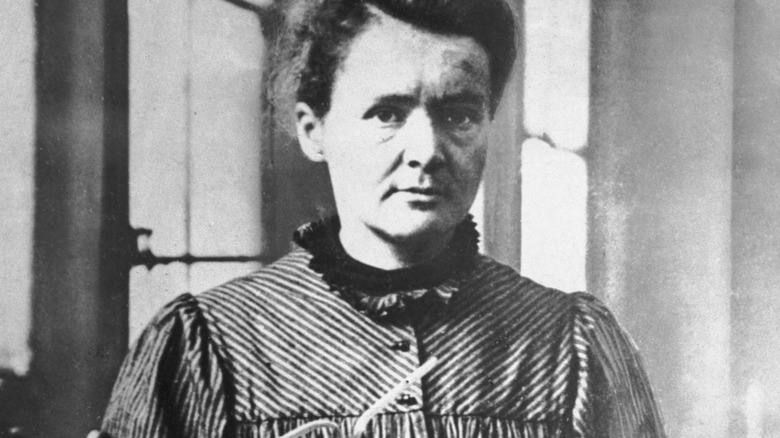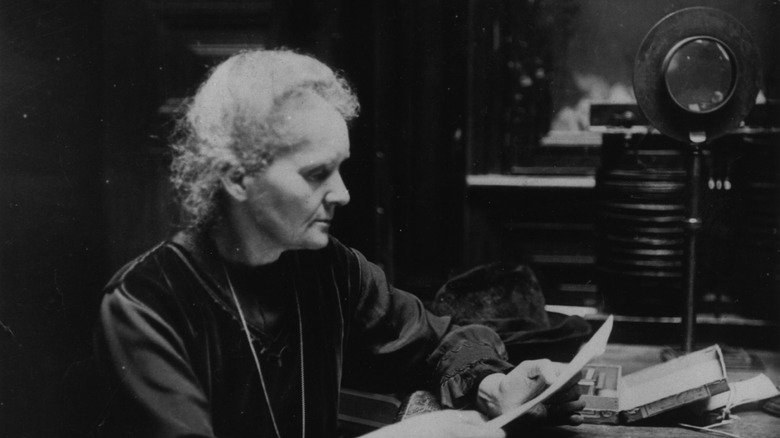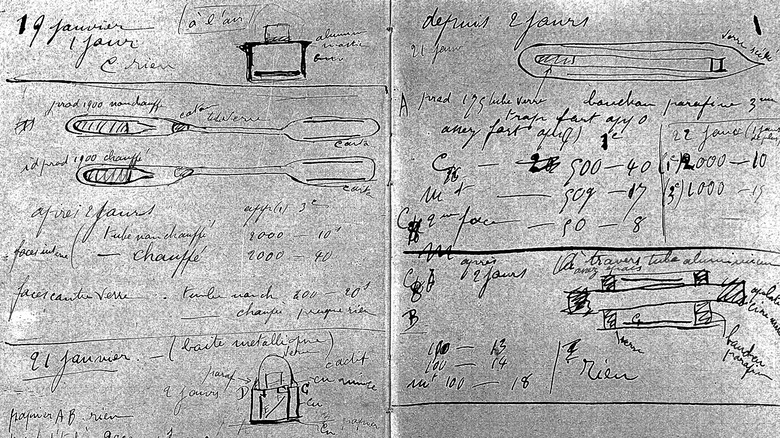Marie Curie's Work In Radioactivity Has Lived On An Unexpected Way
Today, radioactivity is an incredibly useful and sometimes dangerous scientific phenomenon occurring on the planet. As Discover Magazine explains, pretty much everything on the planet radiates something, from rocks to cars to even people. Radiation in its simplest definition is just energy in different forms, like waves and particles, which varies in origin, such as cosmic rays and minerals. Many medical practices depend on radiation, as it helps doctors diagnose illnesses or use x-ray machines (via New York State Department of Health).
It would be completely remiss to talk about radiation and not mention one of the most important figures in its history: Marie Curie. As Britannica says, Marie Curie was best known for her significant contributions to the fields of chemistry and physics, along with advancing a scientific understanding of radiation and its properties. The notebooks that she wrote down scientific observations in today are still radioactive, despite the fact that they are over 100 years old, according to Science Alert. Because of this, anyone who wants to look at her manuscripts at the Bibliothèque Nationale in Paris has to sign a liability waiver.
Who was Marie Curie?
Marie Curie was born on November 7, 1867, in Warsaw, Poland, and had a very promising start in education from an early age. As Britannica explains, Curie was a child prodigy who had an incredible memory and did extremely well in school, according to her peers at the time. However, due to her family's poverty, she was forced into working various jobs, such as teaching and governess work, and higher education was postponed for her. In 1891, Curie decided to move to Paris, where she learned a great deal about science and mathematics through lectures by notable physicists.
A good chunk of Curie's discoveries would happen during her marriage to Pierre Curie. The two discovered elements such as radium and polonium, the former of which is incredibly important in medicine today, particularly radiotherapy. The two would eventually share the 1903 Nobel Prize in Physics with Henri Becquerel, a famous physicist who discovered radiation, for their findings in radioactivity. And though Becquerel discovered radiation before Curie, she was the one who coined the word radioactivity (via Mirion). Curie would then win the 1911 Nobel Prize in Chemistry for discovering polonium and radium. Unfortunately, the same radiation she spent a lifetime studying led to her death in 1934 from aplastic anemia. This condition, which is when the body doesn't produce blood cells, is thought to have been caused by exposure to radiation.
Curie's esteemed notebooks are over a century old and still radioactive
Most people will undoubtedly be familiar with Marie Curie's lifelong exposure to radiation, which, perhaps ironically, has become one of the most well-known stories about Curie's life. However, judgment is somewhat unfair, as the dangerous effects of radiation weren't established during her time. As the American Council on Science and Health says, a fair amount of Curie's research was spent grinding and breaking open rocks to collect radioactive minerals. Both Curie and her husband worked with tons and tons of uranium during their life but were never privy to their actual danger. In many ways, the sacrifice of Curie and her husband's health laid the groundwork for much of scientific study today.
Because of this, the notebooks of Curie and her husband are still radioactive to this day. As Science Alert explains, the notebooks, which are kept at the Bibliothèque Nationale in Paris in special lead-lined boxes, are only accessible to guests if they are willing to undergo precautions. Viewers must both wear protective gear and sign a liability waiver to even view them. The notebooks are radioactive with the element radium 226, which will stay dangerous for about 1,500 more years. Even the bodies of Curie and her husband are still radioactive, which means that their coffins, located in a French mausoleum called the Panthéon, are also lead-lined. While Curie's legacy lives on, the cause of her death still haunts her work.


